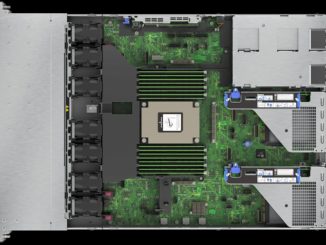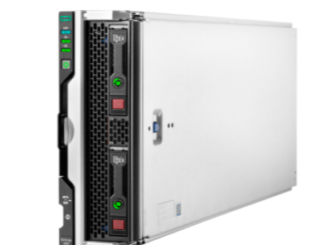
It has taken the better part of a year and a half and some wrangling with the US Department of Justice to get it done, but Hewlett Packard Enterprise has finally completed its $14 billion acquisition of Juniper Networks.
Let the integration begin!
The new HPE Networking business that will be headed up by former Juniper chief executive officer Rami Rahim has some decisions to make about how to bring the HPE, Aruba, and Juniper networking hardware and software portfolios together, but to be fair, there is only some overlap and there are plenty of synergies. And now HPE also has another 10,000 networking experts on the payroll, which will help as both companies try to return to greater relevance in datacenter switching fueled by pretty good businesses in wireless networking (Aruba) and datacenter routing (Juniper).
It was clear a year and a half ago that neither HPE nor Juniper were big enough to take on Cisco Systems in the datacenter as Juniper did decades ago during the Dot Com boom, not with Nvidia coming on strong after its $6.9 billion acquisition of Mellanox Technologies back in 2020 and the GenAI boom that has turned Nvidia into a top five datacenter networking player in a mere few years – leaving Juniper in the dust. Arista Networks, the archrival of Cisco for the past decade and a half and the champion of merchant silicon from Broadcom, has also outgrown Juniper and has surpassed Cisco as the leader in high bandwidth switching in the datacenter. Both Cisco and Arista are anticipating their own AI booms as they compete with Nvidia for scale out networks for AI clusters.
HPE sold its own ProCurve Ethernet switches in the Dot Com boom, and bought 3Com to bolster its position in datacenter switching in April 2010 for $2.7 billion – and still it could not keep pace with Cisco and Arista, and to a lesser extent Juniper. In March 2015, HPE took a different tack and bought Aruba Networks, which was a big player in wireless networks, for around $3 billion. Aruba has been a boon for the Networking division, providing on average about a third of the operating profits of HPE against half that share of its revenues.
Now, Rahim is in charge of HPE Networking and the task of integrating all of the networking assets into a coherent portfolio while not alienating any existing HPE, Aruba, or Juniper customers begins.
In a conference call with Wall Street analysts, industry analysts, and journalists this morning going over the closure of the Juniper deal, neither HPE chief executive officer Antonio Neri nor Rahmin gave out much in the way of details regarding product integration plans. Our question about what would happen with Aruba datacenter switches – yes, Aruba makes its own switch ASICs for some of its datacenter switches and has a partnership with AMD with DPU-goosed switches based on Broadcom ASICs, too – or the Cray “Rosetta” Slingshot switches that HPE got its hands on when it bought the venerable supercomputer maker back in May 2019 for $1.3 billion. The Rosetta Slingshot switches are back at 200 Gb/sec per port in an AI and HPC world that is already at 800 Gb/sec per port and thinking about 1.6 Tb/sec in 2027 and maybe 3.2 Tb/sec in 2029, give or take a year.
It has been a long time since HPE had a conversation with us back in January 2022 expressing its commitment to a Slingshot roadmap while at the same time providing very little in the way of details on that roadmap. We don’t even know about Juniper’s commitment to its own Q5 series ASICs with deep buffers used in its QFX modular switches, its own E5 series ASICs used in the PTX core routers, the Trio 6 series ASICs used in its MX edge routers. Juniper also has various QFX switches based on Broadcom’s Trident and Tomahawk ASICs. All of these ASICs are a couple of years old and we don’t know what the future plan is for them. This is more of a shortcoming on our part, not Juniper’s, and that is because Juniper was focused on service providers mostly. And because Juniper fell out of the top five Ethernet switch vendors list a few years back, we focused on other things. (Huawei Technologies knocked it out, and now Nvidia has put a chair against the door with its massive growth and has even surpassed Huawei.)
The HPE deal for Juniper forces us to take a hard look at Juniper again and ponder what HPE will do with all of these assets now that the deal has passed muster with the US Department of Justice.
Rahim didn’t tip his cards at all when he talked about the task ahead.
“My objective here as the leader of this combined networking business is to build the best networking business really on the planet, one that’s founded in innovation,” Rahim explained. “And we plan on doing this first by starting to focus on our customers and partners. We’re seeing great momentum in both the Juniper portfolio as well as HP Aruba networking, and we want to protect that and immediately, right now, I’m rolling up my sleeves and starting on a customer and market focused, thoughtful integration strategy. And we’re going to be guided in that work that we’re starting now by a true north, which is around secure, AI native, and cloud native networking. And very importantly – this is the one thing I really want everybody here to recognize and to understand – is that all our customers, whether they’re starting their journey on the Aruba side or the Juniper side, are going to have a path to that exciting true north. So it’s too early at this point to provide you with the specifics and the timelines, but that is the strategy that we are embarking on, and nobody gets left behind.”
So forget a conversation about roadmaps for now. It is safe to assume that the Slingshot switch ASICs from Cray and Q5 switch ASICs from Juniper will be merged in some fashion, and that the result will be compliant with the emerging Ultra Ethernet standard. HPE will honor any contracts it has for Slingshot, of course, and it will also honor whatever contracts it has for Q5-based switches. But the future Q6 will almost certainly feature a converged architecture, drawing on elements of both. It is hard to say what will happen with the Aruba wired datacenter switch ASICs, but they could fill in gaps in the Juniper line.
Rahim did say that the two opportunities that HPE had ahead of it were “AI for networks” and “networks for AI,” and this makes perfect sense. This is also the strategy that every network provider will have.
It is interesting to us that the settlement of the lawsuit blocking the Juniper deal by the Department of Justice is not only requiring HPE to sell off its Aruba “Instant On” campus and branch office wireless LAN business to a DOJ-approved buyer within the next 180 days, but is also forcing HPE to license the AI Ops for Mist network management software from Juniper to a third party and give it the source code for this add-on to its network gear. As the DOJ put it a few days ago: “The license will be perpetual, non-exclusive, and include optional transitional support and personnel transfers to facilitate competition.”
We wonder if Palantir will bid on the Mist AI Ops license to become the independent third party vendor making money on it. We wonder why this part of the stack was singled out. At least Uncle Sam is letting HPE keep control of this AI Ops code and benefit from it rather than sell it off, which would be quite mean indeed given that AI for networks is a strategic asset that makes Juniper worth $14 billion in the first place.
Generally speaking, Juniper has been moving along as normally in its service provider and enterprise markets, with revenues averaging a small uptick over the past several quarters and operating income holding more or less steady. Like Cisco and Arista, Juniper has been fishing for an AI angle and is trying to come up with the right bait.
The good news is that 30 percent of the Internet’s traffic, as Neri reminded everyone, still goes through Juniper’s routers. And because of this the deal will be accretive to profits at a GAAP level in the first year. Both HPE’s core systems business and Juniper’s whole business are both profitable so, yeah.
That said, both companies are feeling a little pressure on profits in the most recent year:
That table shows HPE fiscal year against Juniper calendar year, which is the closest alignment we have without doing a bunch of estimating math that won’t change the picture all that much.
We look forward to the Ethernet roadmap discussion and to seeing how HPE is planning to take share away from Cisco, Arista, and Nvidia in both scale up and scale out networks for AI clusters. And maybe some HPC clusters, too.
Comments are closed.







Excuse me: I dont understanding nothing, FIRTS: the pact Dep. J. and HPE binding adquisition to sell licences not esclusive of MIST IA soft (the jewel crown)… ??? SECOND: Otherwise the network division to compete with Cisco co. signify to steal budget of compute division… ???
Luis River wrote “Excuse me: I dont understanding nothing.”
Maybe the goal is to write off huge losses in a couple years. If not, then this doesn’t look like an ideal acquisition to me either.
Unfortunately, I’ve run out of popcorn watching HPE downsize Cray to fit last year’s enterprise datacenters while simultaneously watching this year’s enterprise datacenters grow with AI demands greater than all previous HPC.
Aruba was HPE’s bright spot for networking (Cray Slingshot was a one-off, largely custom bit of hardware with only modest success in the HPC space). Many of Aruba’s brightest left HPE over the past few years, so now it is betting on Juniper, which while a decent company, hasn’t been known as market setter / innovation leader in years. As for HPE, it has been a dead money investment company for years with few breakthrough innovations (its $3B stock buyback was little more than a short-term sugar high for shareholders and a complete waste). Lot of nice people at HPE, but leadership has failed to invest in organic, differentiated innovation for many years now. They continue to watch Nvidia eat an ever larger percentage of their P&L stream, with HPE becoming little more than a reseller of Nvidia technology in many deals. Another tidbit, many of the best and brightest people who worked at HPE moved to Nvidia helping it to become one of the best companies and technology leaders in the world (many others have gone to AMD to help it to try and catch up).
Excuse Realist : HPE + CRAY corporatión they are today world númber one on Supercomputers, that its real, Mr.Realist. The theme its complicate to continued tomorrow. !!